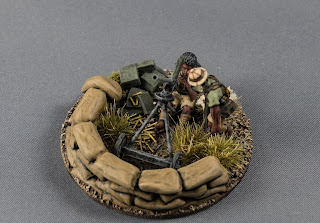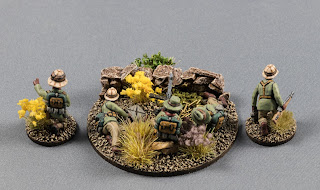Am Freitag traf sich unsere kleine Chain of Command Gruppe wieder einmal auf ein Spiel für unser fiktives Setting in Abessinien (das heutige Äthiopien).
Mai 1939, Mussolini´s Italien hat Albanien überfallen, um seinen Einfluß auf dem Balkan auszudehnen.
Für Großbritannien und Frankreich ist nunmehr die Grenze der Appeasement Politik erreicht.
Um Deutschland nicht zu einem Überfall auf eines seiner Nachbarländer zu ermutigen, will Frankreich dem faschistischen Spuk ein Ende bereiten.
Es hatte in Syrien in den letzten Jahren und Monaten schon zuvor größere Truppenkontingente zusammen gezogen und beschließt, die Italiener in Abessinien anzugreifen, dass diese erst 1936 selbst erobert hatten, trotz Protesten des Völkerbundes.
Zusammen mit einem Platoon Mehal Sefari versucht ein Platoon französischer Fremdenlegion als Vorabkontingent einen italienischen Feldflugplatz in der Nähe der strategisch wichtigen Bahnlinie Addis Abeba–Dschibuti einzunehmen, dessen Garnison aus italienischer Infanterie und gepanzerten Fahrzeugen besteht (Szenario 3: Attack & Defend).
Überblick über das Gefechtsfeld:
Alarmiert von ihren Vorposten, senden die Italiener Patrouillen aus, die bald auf ihre Gegenparts treffen und in Kämpfe verwickelt werden (die Jump Off Points der Legion und Mehal Sefari werden durch clevere Züge der Italiener auf der linken Seite in der kleinen Senke zwischen Dorf und der Plantage gelocked, die italienischen JOP´s befinden sich im Dorf vor der Festung, bei den Nissenhütten und der kleinen Reparaturhalle).
Für die Mehal Sefari wird dies ihre Feuertaufe werden, entsprechend bedarf es einiges Aufwandes der Kommandeure, ihre Truppen zu motivieren, sie können sich aber nicht mit der Zuversicht der Italiener messen, die ob ihrer moderneren Bewaffnung und mit Unterstützung von zwei gepanzerten Fahrzeugen sicher sind, das Gefecht zu ihrem Gunsten entscheiden zu können (Force Moral der Italiener liegt bei 10, die der regulären Fremdenlegion bei 9, die der Mehal Sefari bei 7).
Die motivierenden Ansprachen zeigen bei den Abessiniern aber Wirkung, entschlossen rücken sie in das Dorf am Rande des alten unbesetzten Fort´s vor und entreißen dem Gegner die Initiative (Wurf von 2 Sechsen bedeutet, auch die nächste Phase gehört den Mehal Sefari, die den gegnerischen JOP im Dorf besetzen, so daß dieser vom Gegner nicht benutzt werden kann).
Südlich davon rückt auch das Platoon der Fremdenlegion in Richtung Flugplatz vor; eine Sektion versucht im Laufschritt den gegenüberligenden Hügel mit seinem Palmenwäldchen zu erreichen.
Die italienischen Verteidiger besetzen eiligst die vorbereiteten Stellungen, im Hintergrund kommt ein FIAT 611 in voller Fahrt herangebraust, um den Mehal Sefari einen blutigen Empfang zu bereiten:
Aber auch die Mehal Sefari sind jetzt kampfbereit. Eines der beiden Half-Platoon´s versucht die Deckung der kleinen Senke so gut wie möglich auszunutzen, um das Feuer der italienischen Infanterie so gut es geht zu erwidern:
Bringt das lMG am Dorfrand und das mMG-Team in Deckung eines Wracks einer Tankette in Stellung:
Während das andere Half-Platoon die schwierigste Aufgabe übernimmt, nämlich das Dorf gegen das Feuer der italienischen Infanterie und den angreifenden FIAT 611 zu halten.
Um die Chancen zu erhöhen, wird es nicht nur durch ein vorgerücktes 20mm SEMAG unterstützt (das zumindest leicht gepanzerte Fahrzeuge und Panzer bekämpfen kann, wie sie die Italiener ins Feld führen können), sondern zur moralischen Unterstützung wird eine Fahne aufgepflanzt (verhindert einen Schockpunkt pro Phase) und hier wird der Amsa aleqa (Inferior Senior Leader) auch durch den britischen Militärberater unterstützt.
Ein Überblick über die aktuelle Lage - während sich die Verluste der angreifenden Abessinier in Grenzen halten und wegen der Größe ihrer Sektionen noch gut zu verkraften sind, summieren sie sich bei den italienischen Verteidigern bedenklich, die von Salven aus lMG, mMG, Infaterie und Gewehrgranaten der Legion niedergehalten werden.
Bisher haben auch die Zwillings-MG des FIAT 611 kaum Wirkung gezeigt, der hinter einem LKW Deckung gesucht hat und den Turm für die nächste Salve seiner MG´s auf die Abessinier ausgerichtet hat.
Und noch während ein weiterer Schützenpanzer der Italiener zur Unterstützung heranrückt, ereilt den FIAT 611 sein Schicksal - eine Salve des SEMAG setzt seine Hauptbewaffnung irreparabel außer Gefecht, was der italienischen Moral nicht zuträglich ist, zumal kurz darauf auch die italienische Infanteriesektion die Flucht ergreift, nachdem sich die Verluste anhäufen und noch dazu ihr NCO schwer verwundet wird (durch den ausgeschalteten Schützenpanzer, die gebrochene Sektion und den verwundeten Leader sinkt die Force Moral der Italiener schlagartig von 10 auf 6, dazu kommt noch der verlorene JOP im Dorf).
Auf den Erfolg kann man sich schon einmal eine Tasse Tee genehmigen.
Die Infanterie ist geflohen und mußte ihren verwunderten NCO zurücklassen, der FIAT ausgeschaltet und von einer Umklammerung durch die vorrückende Legion bedroht, versuchen die Italiener per LKW noch Infanterie zur Entlastung in den Kampf zu werfen.
Außerdem rücken nochmals 2 italienische Infanterie-Sektionen nach vorne. Während eine Sektion wieder Verteidigungsposition bezieht, versucht die andere Sektion in einer Verzweiflungsaktion ins Dorf vorzustoßen, um die Drohende Umklammerung durch Mehal Sefari und Legion zu durchbrechen.
Sie werden aber sofort ins Kreuzfeuer durch das komplette Platoon Mehal Sefari genommen, unterstützt durch das mMG-Team und die Bedienung des SEMAG, die schnell von AP- auf HE-Munition wechselt, so daß der italienische Entlastungsangriff unter immensen Verlusten zusammenbricht. Nur wenige Italienier kommen mit dem Schrecken davon, während ihre Kameraden um sie herum fallen.
Dem italienischen Befehlshaber bleibt nichts weiter übrig, als in dieser Situation den Rückzug zu befehlen; seine vorderen Linien sind zusammengebrochen oder nicht länger zu halten, da sich die Zange zu schließen beginnt und durch eine vorrückende Sektion der Legion ein Abschneiden seiner Kommunikationslinie droht.
Die Verbündeten beschließen, in dieser Situation vorerst das Eintreffen der Hauptmacht in den eroberten Positionen abzuwarten.
Aufgrund der strategischen Lage ist mit einem entschlossenen Gegenangriff der Italiener innerhalb kürzester Zeit zu rechnen und somit weiteren für beide Seiten verlustreichen Kämpfen.
Mai 1939, Mussolini´s Italien hat Albanien überfallen, um seinen Einfluß auf dem Balkan auszudehnen.
Für Großbritannien und Frankreich ist nunmehr die Grenze der Appeasement Politik erreicht.
Um Deutschland nicht zu einem Überfall auf eines seiner Nachbarländer zu ermutigen, will Frankreich dem faschistischen Spuk ein Ende bereiten.
Es hatte in Syrien in den letzten Jahren und Monaten schon zuvor größere Truppenkontingente zusammen gezogen und beschließt, die Italiener in Abessinien anzugreifen, dass diese erst 1936 selbst erobert hatten, trotz Protesten des Völkerbundes.
Zusammen mit einem Platoon Mehal Sefari versucht ein Platoon französischer Fremdenlegion als Vorabkontingent einen italienischen Feldflugplatz in der Nähe der strategisch wichtigen Bahnlinie Addis Abeba–Dschibuti einzunehmen, dessen Garnison aus italienischer Infanterie und gepanzerten Fahrzeugen besteht (Szenario 3: Attack & Defend).
Überblick über das Gefechtsfeld:
Alarmiert von ihren Vorposten, senden die Italiener Patrouillen aus, die bald auf ihre Gegenparts treffen und in Kämpfe verwickelt werden (die Jump Off Points der Legion und Mehal Sefari werden durch clevere Züge der Italiener auf der linken Seite in der kleinen Senke zwischen Dorf und der Plantage gelocked, die italienischen JOP´s befinden sich im Dorf vor der Festung, bei den Nissenhütten und der kleinen Reparaturhalle).
Für die Mehal Sefari wird dies ihre Feuertaufe werden, entsprechend bedarf es einiges Aufwandes der Kommandeure, ihre Truppen zu motivieren, sie können sich aber nicht mit der Zuversicht der Italiener messen, die ob ihrer moderneren Bewaffnung und mit Unterstützung von zwei gepanzerten Fahrzeugen sicher sind, das Gefecht zu ihrem Gunsten entscheiden zu können (Force Moral der Italiener liegt bei 10, die der regulären Fremdenlegion bei 9, die der Mehal Sefari bei 7).
Die motivierenden Ansprachen zeigen bei den Abessiniern aber Wirkung, entschlossen rücken sie in das Dorf am Rande des alten unbesetzten Fort´s vor und entreißen dem Gegner die Initiative (Wurf von 2 Sechsen bedeutet, auch die nächste Phase gehört den Mehal Sefari, die den gegnerischen JOP im Dorf besetzen, so daß dieser vom Gegner nicht benutzt werden kann).
Südlich davon rückt auch das Platoon der Fremdenlegion in Richtung Flugplatz vor; eine Sektion versucht im Laufschritt den gegenüberligenden Hügel mit seinem Palmenwäldchen zu erreichen.
Die italienischen Verteidiger besetzen eiligst die vorbereiteten Stellungen, im Hintergrund kommt ein FIAT 611 in voller Fahrt herangebraust, um den Mehal Sefari einen blutigen Empfang zu bereiten:
Aber auch die Mehal Sefari sind jetzt kampfbereit. Eines der beiden Half-Platoon´s versucht die Deckung der kleinen Senke so gut wie möglich auszunutzen, um das Feuer der italienischen Infanterie so gut es geht zu erwidern:
Bringt das lMG am Dorfrand und das mMG-Team in Deckung eines Wracks einer Tankette in Stellung:
Während das andere Half-Platoon die schwierigste Aufgabe übernimmt, nämlich das Dorf gegen das Feuer der italienischen Infanterie und den angreifenden FIAT 611 zu halten.
Um die Chancen zu erhöhen, wird es nicht nur durch ein vorgerücktes 20mm SEMAG unterstützt (das zumindest leicht gepanzerte Fahrzeuge und Panzer bekämpfen kann, wie sie die Italiener ins Feld führen können), sondern zur moralischen Unterstützung wird eine Fahne aufgepflanzt (verhindert einen Schockpunkt pro Phase) und hier wird der Amsa aleqa (Inferior Senior Leader) auch durch den britischen Militärberater unterstützt.
Ein Überblick über die aktuelle Lage - während sich die Verluste der angreifenden Abessinier in Grenzen halten und wegen der Größe ihrer Sektionen noch gut zu verkraften sind, summieren sie sich bei den italienischen Verteidigern bedenklich, die von Salven aus lMG, mMG, Infaterie und Gewehrgranaten der Legion niedergehalten werden.
Bisher haben auch die Zwillings-MG des FIAT 611 kaum Wirkung gezeigt, der hinter einem LKW Deckung gesucht hat und den Turm für die nächste Salve seiner MG´s auf die Abessinier ausgerichtet hat.
Und noch während ein weiterer Schützenpanzer der Italiener zur Unterstützung heranrückt, ereilt den FIAT 611 sein Schicksal - eine Salve des SEMAG setzt seine Hauptbewaffnung irreparabel außer Gefecht, was der italienischen Moral nicht zuträglich ist, zumal kurz darauf auch die italienische Infanteriesektion die Flucht ergreift, nachdem sich die Verluste anhäufen und noch dazu ihr NCO schwer verwundet wird (durch den ausgeschalteten Schützenpanzer, die gebrochene Sektion und den verwundeten Leader sinkt die Force Moral der Italiener schlagartig von 10 auf 6, dazu kommt noch der verlorene JOP im Dorf).
Auf den Erfolg kann man sich schon einmal eine Tasse Tee genehmigen.
Die Infanterie ist geflohen und mußte ihren verwunderten NCO zurücklassen, der FIAT ausgeschaltet und von einer Umklammerung durch die vorrückende Legion bedroht, versuchen die Italiener per LKW noch Infanterie zur Entlastung in den Kampf zu werfen.
Außerdem rücken nochmals 2 italienische Infanterie-Sektionen nach vorne. Während eine Sektion wieder Verteidigungsposition bezieht, versucht die andere Sektion in einer Verzweiflungsaktion ins Dorf vorzustoßen, um die Drohende Umklammerung durch Mehal Sefari und Legion zu durchbrechen.
Sie werden aber sofort ins Kreuzfeuer durch das komplette Platoon Mehal Sefari genommen, unterstützt durch das mMG-Team und die Bedienung des SEMAG, die schnell von AP- auf HE-Munition wechselt, so daß der italienische Entlastungsangriff unter immensen Verlusten zusammenbricht. Nur wenige Italienier kommen mit dem Schrecken davon, während ihre Kameraden um sie herum fallen.
Dem italienischen Befehlshaber bleibt nichts weiter übrig, als in dieser Situation den Rückzug zu befehlen; seine vorderen Linien sind zusammengebrochen oder nicht länger zu halten, da sich die Zange zu schließen beginnt und durch eine vorrückende Sektion der Legion ein Abschneiden seiner Kommunikationslinie droht.
Die Verbündeten beschließen, in dieser Situation vorerst das Eintreffen der Hauptmacht in den eroberten Positionen abzuwarten.
Aufgrund der strategischen Lage ist mit einem entschlossenen Gegenangriff der Italiener innerhalb kürzester Zeit zu rechnen und somit weiteren für beide Seiten verlustreichen Kämpfen.


























































